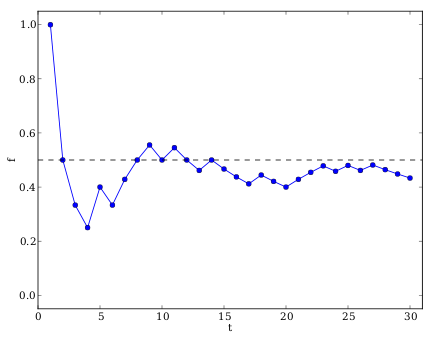A die is tossed 44 times and lands 5 times on the number 3.
What is the relative frequency of observing the die land on the number 3? Write your answer correct to 2
decimal places.
Recall the formula:
\[f = \frac{p}{t}\]
Identify variables needed:
\begin{align*}
p & = \text{number of positive trials} = \text{5} \\
f & = \text{total number of trials} = \text{44}
\end{align*}
Calculate the relative frequency:
\begin{align*}
f & = \frac{p}{t} \\
& = \frac{\text{5}}{\text{44}} \\
& = \text{0,11}
\end{align*}
Therefore, the relative frequency of observing the die on the number 3 is \(\text{0,11}\).
A coin is tossed 30 times and lands 17 times on heads.
What is the relative frequency of observing the coin land on heads? Write your answer correct to 2
decimal places.
Recall the formula:
\[f = \frac{p}{t}\]
Identify variables needed:
\begin{align*}
p & = \text{number of positive trials} = \text{17} \\
f & = \text{total number of trials} = \text{30}
\end{align*}
Calculate the relative frequency:
\begin{align*}
f & = \frac{p}{t} \\
& = \frac{\text{17}}{\text{30}} \\
& = \text{0,57}
\end{align*}
Therefore, the relative frequency of observing the coin on heads is \(\text{0,57}\).
A die is tossed 27 times and lands 6 times on the number 6.
What is the relative frequency of observing the die land on the number 6? Write your answer correct to 2
decimal places.
Recall the formula:
\[f = \frac{p}{t}\]
Identify variables needed:
\begin{align*}
p & = \text{number of positive trials} = \text{6} \\
f & = \text{total number of trials} = \text{27}
\end{align*}
Calculate the relative frequency:
\begin{align*}
f & = \frac{p}{t} \\
& = \frac{\text{6}}{\text{27}} \\
& = \text{0,22}
\end{align*}
Therefore, the relative frequency of observing the die on the number 6 is \(\text{0,22}\).

